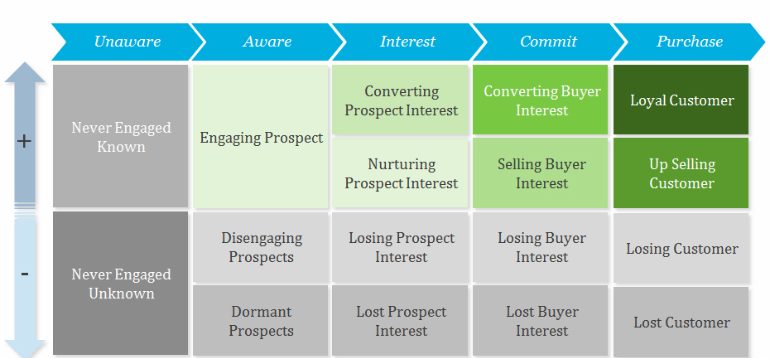The short answer: nothing
When Henry Ford decided to make a car for the “every day” working person, he essentially created a product targeting a segment, based on a need he saw in the market. Since 1908, the ability to segment has increased massively. With the advent of digital marketing, there has never been more data gathered on buyers, buying groups and their individual and collective behaviors. This in turn has led to the use of lead scoring programs to separate the wheat from the digital chaff and identify the Marketing Qualified Leads (MQLs) to pursue.
The problem with today’s “funnel vision” is that it over-simplifies the complex business buying process, painting it as a simple linear progression from initial inquiry to sales qualified opportunity. This is great when you need to present a digestible report on current pipeline to management. Not so helpful when it comes to guiding the development of targeted marketing programs.
Lead scoring programs group together buyers who actually have very little in common in terms of their buying stage and information needs. Listen to enough response management interviews and I guarantee you will start to think differently about the ability of your digital programs and lead scoring programs to identify, nurture and qualify leads. When you reach them on the phone, most high-scoring contacts are either completely bemused by the unsolicited approach, or will explain that they are well aware of what you have to offer and already in contact with sales.
The reality is that only a very small group of businesses are in the market to buy at any given point in time. And yet every business within the universe may eventually purchase. Focus too much marketing and business development time on the ready-to-buy segment and the risk is that the remaining 98% of the database are poorly served or completely neglected, jeopardizing future pipeline.
Make 2021 the year to try something new (and old)
The real irony here is that in B2B marketing we used to think about engaging customers using segments. Except we called them mailing lists and we used to buy them from publishers and list brokers who applied tried and tested techniques to organize and enrich their data. Somehow this good practice got lost in the digital madness, because it was primarily associated with analog communication channels like direct mail.
Email service providers and then marketing automation platforms made it easy to digitize and bring the direct marketing function in-house. Somewhere along the way, seduced by the promise of behavioral triggers, hyper-segmentation and one-to-one marketing, the discipline of good data management and analytic method was lost. When there are no hard costs associated with sending a higher volume of communications, it’s all too easy to fall into the trap of blasting the entire database in the hope of a few incremental form submissions. And slowly, but surely, prospective buyers tune out, or opt out entirely.
The solution: start thinking about segments
All is not lost. One good thing about our marketing technology investments over the past 10-15 years is that we are sat on a mountain of data that can be used to create segments. But be warned: that data will likely be incomplete and require some significant engineering to make it actionable.
One of our more progressive clients, who recognized the need to put real rigor around their data, is in year four of their journey. They are only now at the point where they have a complete view of historic marketing and sales behavior (descriptive analytics) and can begin testing with real segments to understand what drives conversion to pipeline. A partner like MarketOne can help cut that timeline by 75-80%.
Below are some examples of how we might start to define segments for a B2B client. These segments are based on data typically available inside most marketing automation platforms and CRM systems.

Scoring can be engineered to use every action or inaction to identify which segment a contact currently fits within and thereby determine the most appropriate treatment: whether that’s provoking a response from those that have never engaged, nurturing those that are interested, or re-engaging those that appear to be losing interest.
For one software client, MarketOne has been conducting test-measure-learn activity to generate leads from previously disqualified segments. A blend of targeted email and calling activity to one segment of accounts (where between 2-5 contacts engaged 4-9 months ago) has resulted in conversion rates 25x higher than the previous strategy (contact-based call-backs after 3 months).
Interest doesn’t necessarily signal intent. And a disinterested contact may belong to an account with intent.
If marketing owns the top of the funnel, its job should be to help the buyer and accelerate their learning, determine fit and facilitate an appropriate next step, not force them into a sales conversation before they are ready. Marketing automation and lead scoring programs can help gauge a buyer’s level of interest, but that interest does not always translate into immediate intent. They may still need to create a business case, find budget and build consensus among influencers, users and decision makers before they can commit to a sales discussion.
Keep in mind that the influencers and users you see in your funnel – who may never become qualified leads themselves – are also part of the decision making process. Give them a substandard experience and your solution will never make the consideration set, no matter how carefully you cultivate the ultimate decision maker.
Instead of setting out with the goal of getting an appointment, treat qualification calls as buyer research that may help plug gaps in knowledge or garner insight that digital behavior alone would have never revealed.
Integrate and unify. Divide and conquer.
- Focus on unifying and collecting data across marketing, sales and delivery. Observe what buyers do. Listen to what they say. Staff a team focused on engineering and analyzing this data and segmenting the database.
- Take the nurturing process out of its digital silo and work with an inside sales or business development team to start having connected conversations across both digital and telemarketing channels.
- Don’t try to do it alone. Find a partner that understands how and when to use phone, chat and email to engage multiple buyers and influencers within an account – and how to capture and structure data to build segments and inform future interactions.


